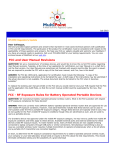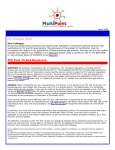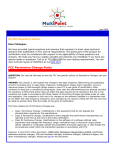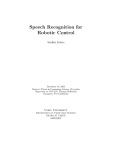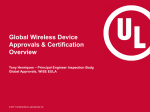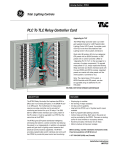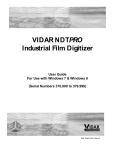Download Adding a Bluetooth Module to an Existing Grant
Transcript
August 2005 EMC Regulatory Update Dear Colleague, We have provided typical questions and answers that represent in most cases technical opinions with justification in FCC and CE requirements. The particulars of the product for certification must be considered with respect to the applicability of these questions and answers. We hope you find our update valuable and welcome your feedback if you have any special needs or questions. Call at 703-689-0368 or view archived issues of MultiPoint at our web site. Adding a Bluetooth Module to an Existing Grant QUESTION: Our company manufactures handheld personal digital assistants (PDAs) and we have certified our device with an 802.11a/b/g WLAN module. Our PDA was approved by the Commission for “body SAR”. Now, we would like to add a separately approved 2 mW Bluetooth (BT) module using the Class II Permissive Change process. Assuming SAR values in both the 2.4 GHz and 5 GHz bands have not changed by more than 10% after retest, can we send our device with the BT module to a TCB for approval? ANSWER: In accordance with FCC Rule Part 2.1043, BT modules cannot be added to PDA/WLAN grants because the BT module has a grant of its own. However, the Commission may allow TCBs to grant "collocation" of the BT module with the original PDA grant using the Permissive Change process for the PDA grant under the following conditions: 1. 2. 3. 4. All conditions of the BT modular approval were met. Requires a collocation evaluation under the BT grant as well. Retest PDA with BT module; review SAR test of the dominant transmitter (PDA WLAN) with the BT module both on and off and the test result does not affect the dominant transmitter. The PDA grant condition should be modified to include reference to the specific collocation condition tested. FCC Modular Approvals of Circuit Boards QUESTION: We recently reviewed an application on the Commission’s website that is certified as a transmitter circuit board. The product is a developer kit which consists of a Part 15 transceiver on a printed circuit board and sold without a case. There is no “modular approval” associated with this device. Does the Commission allow certification of such devices? We have also seen a similar lower power device from another manufacturer who uses the same referenced grant as proof that the Commission allows transmitter circuit boards to be used in modular applications. ANSWER: The Commission has only recently allowed transmitter circuit boards to be certified for "evaluation" or "demonstration" purposes as long as they are not intended to be used as a module incorporated within a host device or any other system. The power output is conducted and the antenna used for such transmitters must be installed to provide a separation distance of at least 20 cm from all persons and must not be co-located or operating in conjunction with any other antenna or transmitter. The end-user must be provided with specific operating instructions for satisfying RF exposure compliance. Marketing of such devices is not intended for the general public. Certification of transmitter circuit boards requires the appropriate grant conditions and user instructions to limit marketing and use of the device. The user manual must agree with the above conditions. Such devices must comply with Section 15.203 of the Commission's rules and must not provide user instructions for use and evaluation with unauthorized antennas. Transmitter circuit boards used for applications in host devices must be modular approved and comply with the modular approval requirements including shielding requirement. FCC Rules for Microphone Transmitters QUESTION: We are the manufacturer of a microphone which transmits from 88-108 MHz. The microphone’s transmitted signal can be received with an “off-the-shelf” radio headset. Can we test and certify this product under FCC rules and regulations? Also, is it possible to use 73-76 MHz under the FCC rules? ANSWER: The Commission’s rule Part 15.237 allows operating in the 70 MHz range, but strictly for auditory assistance devices which cannot be a regular microphone. However, Part 74 allows wireless microphones in the 54–72 MHz and 76–88 MHz ranges. It appears that the only possible frequency to use under the 88-108 MHz range of your device, which a regular radio headset can receive, is 88 MHz under FCC Part 74 allowed by the Commission. Your microphone also falls under Part 74 for the 73-76 MHz range when using 76 MHz within the 76-88 MHz band of Part 74. However, if the microphone is designed as part of a FM transmitter and meets the following conditions: (a) emissions from the intentional radiator shall be confined within a band 200 kHz wide centered on the operating frequency and the 200 kHz band shall lie wholly within the frequency range of 88– 108 MHz, (b) the field strength of any emissions within the permitted 200 kHz band shall not exceed 250 microvolts/meter at 3 meters. The emission limit in this paragraph is based on measurement instrumentation employing an average detector. The provisions in Part 15.35 for limiting peak emissions apply, and (c) The field strength of any emissions radiated on any frequency outside of the specified 200 kHz band shall not exceed the general radiated emission limits in Part 15.209; then there is the possibility the device may fall under 15.239 unliscensed band from 88 - 108 MHz. TCB Audit Requirements QUESTION: We are the manufacturer of several FCC approved products and were recently asked for a sample by our Telecommunication Certification Body (TCB) to be audited. What are the post market surveillance requirements for a TCB? ANSWER: Part 2 of the FCC Rules requires TCBs to conduct appropriate post-market surveillance activities in accordance with ISO/IEC Guide 65. The following post-market surveillance audit procedure is an example of a method that meets this requirement. The post-market surveillance is based on type testing of a percentage of the total number of product types the TCB has certified. • The post-market surveillance audit consists of the following: 1. Sample Selection. When selecting the samples to be audited, the TCB should give consideration to the following: (1) New technology products, (2) Products of new applicants, (3) Products tested by a new laboratory, (4) Products with a history of non-compliance, (5) Products with test reports which may be sufficient for approval but raise question for continued compliance, (6) Requests from the FCC for an audit to be performed on specific product types, (7) Products with potential impact on licensed radio services, the public switched telephone network (PSTN) or user from a non-compliant device. Sample Rate. The number of samples to be audited by the TCB shall be based on the following: (1) The total number of product types audited by the TCB shall consist of at least 2 percent of the total number of products certified by the TCB for a given year, (2) If the TCB has certified products subject to the RF Radiation Exposure requirements (Specific Absorption Rate (SAR) on handsets), then such products shall be included in the total number of products audited. At least 1 percent of the products subject to SAR measurements and certified by the TCB for the given year shall be audited, (3) When calculating the number of products to be audited, the number shall be rounded up to the next whole number. Obtain Sample. The TCB may obtain a sample by one of the following methods: (1) Request the Grantee to submit a sample of the product certified. (The FCC should be notified when the grantee refuses or fails to reply after two requests for a sample.) or (2) Buy a sample product locally. Evaluation. The sample shall be assessed by the TCB to determine compliance with the Commission’s rules: (1) Complete testing to all of the Commission’s requirements is not required; however, sufficient testing shall be performed to allow the TCB to evaluate those requirements most likely to be in non-compliance, (2) Testing shall be performed by personnel from the TCB. Non-core testing may be performed at either the TCB’s testing facilities or at a subcontracted test facility, (3) The TCB shall examine the sample to determine compliance with the Commission's labeling and user instruction requirements. 2. 3. 4. • • • • • If during the auditing process the TCB finds that a product fails to comply with the FCC requirements, then the TCB shall immediately notify the Grantee and the FCC. A follow-up report shall be provided to the FCC by the TCB, within 30 days of the notification of non- compliance, of the action taken or that will be taken by the Grantee to correct the situation. The TCB shall submit to the FCC, within 30 days of such a request, reports of surveillance activities carried out by the TCB. The TCB may be required to test a product certified by the TCB and report its findings to the FCC within 30 days to support compliance investigations. The TCB may perform other types of surveillance, provided such activities are no more burdensome than type testing on the Grantee of certification. Types of surveillance other than type testing are subject to review and acceptance by the FCC staff. INTERNATIONAL UPDATE US: FCC Modifies Wireless Rules to Promote Greater Access to Broadband On August 9, 2005, the Commission released Report and Order WT Docket No. 03-264 in an effort to streamline and harmonize licensing provisions in the wireless radio services (WRS) that were identified in part during the Commission’s 2000 and 2002 biennial regulatory reviews. The Commission believes streamlining existing rules will clarify spectrum rights and obligations and optimize flexibility for WRS licensees, fulfill the Commission's mandate under Section 11 of the Communication's Act, and support efforts to maximize the public benefits derived from the use of the radio spectrum. The following changes were made in this Report and Order: • • • • • • • • • • • • • Modified the rules to classify a deletion of a frequency and/or transmitter site from a multi-site authorization under Part 90 as a minor modification. Retain the references to ERP and EIRP in the rules. Eliminate the transmitter-specific posting requirement of Part 22 licensees. Eliminate Part 24 transmitter output power limits. Retain the frequency coordination requirement for incumbent licensees operating on 800 MHz General Category frequencies and for site-based 800 MHz General Category applications filed after 800 MHz re- banding. Conform the Emission Mask G to a modulation independent mask that places no limitation on the spectral power density profile within the maximum authorized bandwidth. Eliminate Section 90.607(a) of the rules requiring the filing of certain outdated supplemental information. Eliminate the loading requirement and references to the “waiting list” in Section 90.631(d) of the rules, and eliminate Section 90.631(i) which is no longer necessary because the 900 MHz specialized mobile radio (SMR) renewal period it references has long passed. Modify Section 90.635 of the rules to remove the distinction between urban and suburban sites when setting the maximum power and antenna heights limits for conventional 800 MHz and 900 MHz systems. Eliminate the power limitations on systems with operational radii of less than 32 kilometers. Eliminate Section 90.653 of the rules which specifies no limitation on the number of system authorizations to operate within a given geographic area as redundant. Eliminate Section 90.658 of the rules which provides that site-based licensees of trunked SMR systems must provide loading data in order to either acquire additional channels or renew their authorizations. Modify Section 90.693 of the rules to eliminate the necessity of incumbent 800 MHz SMR licensees filing notifications of minor modifications in certain circumstances. Eliminate Section 90.737 of the rules which requires the filing of supplemental progress reports for 220 MHz Phase I licensees. Additionally, the Commission requests comment on whether to 1) implement a spectral density model to the radiated power rules, 2) further increase radiated power limits, 3) specify radiated power as an average rather than peak, and 4) apply the radiated power rule changes to other services. • FCC Link EU: New Standards Released This Past Month This is a shortened list of the CENELEC standards published during the past month: • • • • • EN 55016-2-2:2004/A2:2005: Specification for radio disturbance and immunity measuring apparatus and methods -- Part 2-2: Methods of measurement of disturbances and immunity Measurement of disturbance power CLC/TC 210 2005-08-11 EN 55016-2-3:2004/A2:2005: Specification for radio disturbance and immunity measuring apparatus and methods -- Part 2-3: Methods of measurement of disturbances and immunity Radiated disturbance measurements (Amplitude probability distribution (APD) - Measurement method) CLC/TC 210 2005-08- 11 EN 55016-2-1:2004/A1:2005: Specification for radio disturbance and immunity measuring apparatus and methods -- Part 2-1: Methods of measurement of disturbances and immunity Conducted disturbance measurements CLC/TC 210 2005-08-11 EN 55016-2-3:2004/A1:2005: Specification for radio disturbance and immunity measuring apparatus and methods -- Part 2-3: Methods of measurement of disturbances and immunity Radiated disturbance measurements (Measurement methods above 1 GHz) CLC/TC 210 200508-11 EN 50065-4-7:2005: Signaling on low-voltage electrical installations in the frequency range 3 kHz to 148,5 kHz and 1,6 MHz to 30 MHz -- Part 4-7: Portable low voltage decoupling filters Safety requirements CLC/SC 205A 2005-07-29 • Cenelec Link EU: Additional Spectrum Opened The EU has opened 2 additional bands for WiFi use in order to create expansion in the digital economy and to protect other radio spectrum users from harmful interference. The Commission decision, which is to be implemented by Member States by October 31, 2005, makes two specific frequency bands available (5150- 5350 MHz and 5470-5725 MHz). • EU Link Canada: New Standard Released Industry Canada recently released a new standard: Standard Radio System Plan (SRSP) - Technical Requirements for Fixed Line-of-Sight Radio Systems Operating in the Bands 17.8-18.3 GHz and 19.3-19.7 GHz (SRSP-317.8, Issue 1). This standard states the technical requirements for low, medium and high capacity, point-to-point radio systems using digital modulation. It replaces SRSP-317.7 Issue 1, SRSP- 318.5 Issue 2 and SRSP 318.8, Provisional Issue 1 and takes into account the spectrum policy decisions announced in SP 3-30 GHz under Gazette Notice DGTP-008-04. • Link to standard ABOUT US RTL has provided EMC compliance engineering & testing services since 1988 and has a superior reputation with both the Federal Communications Commission and others in the industry. RTL provides testing services to meet the emissions, immunity, and safety requirements of the European EMC Directive and the EU R&TTE Directive, all FCC rules and regulations, VCCI (Japan), ACMA (Australia), and other international standards. A special thank you to those who have recommended and contributed articles for our newsletter. Please continue to forward new and interesting material to our attention: [email protected]. We respect the privacy of our customers and colleagues. If you would like to cancel your MultiPoint updates, please follow the instructions at the end of this email. The information in the MultiPoint update is subject to change without notice. Learn More email: [email protected] phone: 703-689-0368 web: http://www.rheintech.com Last revised: August 15, 2005 Rhein Tech Laboratories, Inc. | 360 Herndon Pkwy, #1400 | Herndon | VA | 20170






